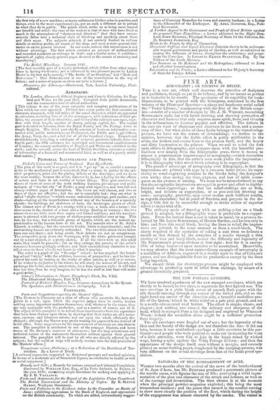FINE ARTS.
ACROGRAPHY ; OR ETCHING IN RELIEF.
Tats is a new art, which well deserves the attention of designers and publishers, though as yet in its infancy, and by no means so perfect as is desirable in its results The specimens of its capability for book- illustrations, to be printed with the letterpress, contained in the first volume of the Illustrated Spectator—a cheap and handsome serial called the "Tudor Library," commencing with the first of the British essay- ists—consist of a number of designs by Mr. J. M. WRIGHT, resembling STOTHARD'S style, but with better drawing, and showing perception of character and humour that only requires more spirit, force, and vivacity in the delineations, to become popular and effective. The defects in the cuts are want of sharpness and clearness in the lines, and a mono- tony of tint : but what share of these faults belongs to the transferring- process, we have not the means of determining; we incline to the opinion, however, that the feeble effect is partly attributable to the artist, the broken and coarse lines to the process itself, and the heavy and dirty impression to the printer. When we call to mind the first rude efforts in lithography, and compare them with the beautiful pro- ductions now issuing from the lithographic press, there is reason to expect a proportionate improvement in acrography—which resembles lithography in this, that the artist's own work yields the impression : it is to lithography what wood-block printing is to copperplate.
The peculiar advantage of acrography over lithography, is that the impressions are printed with type by a common letter-press : its supe- riority to wood-engraving consists in the blocks being the designer's own work ; thus saving the time, expense, and loss of spirit conse- quent on the process of cutting. We must not be misunderstood to say that the acrographic impressions are equal in power and effect to highly- finished wood-engravings; or that the relief-etchings are as firm, bright, and delicate as copperplate, or as pen-and-ink drawing on stone : acrography, probably, may never realize such brilliant results, as regards execution ; but in point of freedom and purpose in the de- sign, it bids fair to be successful enough to invite artists of superior talent to make trial of it.
The ordinary mode of drawing with an etching-point on a black ground is adopted, but a lithographic stone is preferable to a copper- plate. From the incised lines a cast is taken in metal, by a process in- vented by Mr. Louis SCHONBERG, of Hatton Garden, and known only to him ; and from this metal block, having the lines in relief, the impres- sions are printed, in the same manner as from a wood-block. The nicety required in the operation of taking a cast from so delicate a mould as that formed by the scratches of a needle through a thin coating of wax and lamp-black, makes the difficulty and ingenuity of Mr. SCHONBERG'S process obvious at first sight : how far it is suscep- tible of being improved upon remains to be ascertained. Meanwhile, we may observe that the most extraordinary example of acrography is a medallion of Addison, engraved in a similar style to that of Com.ss's patent, and not distinguishable from its productions except by the lines being imperfect.
We should think the electrotype process might be employed with advantage in producing casts in relief from etchings; by means of a ground chemically prepared.


























 Previous page
Previous page